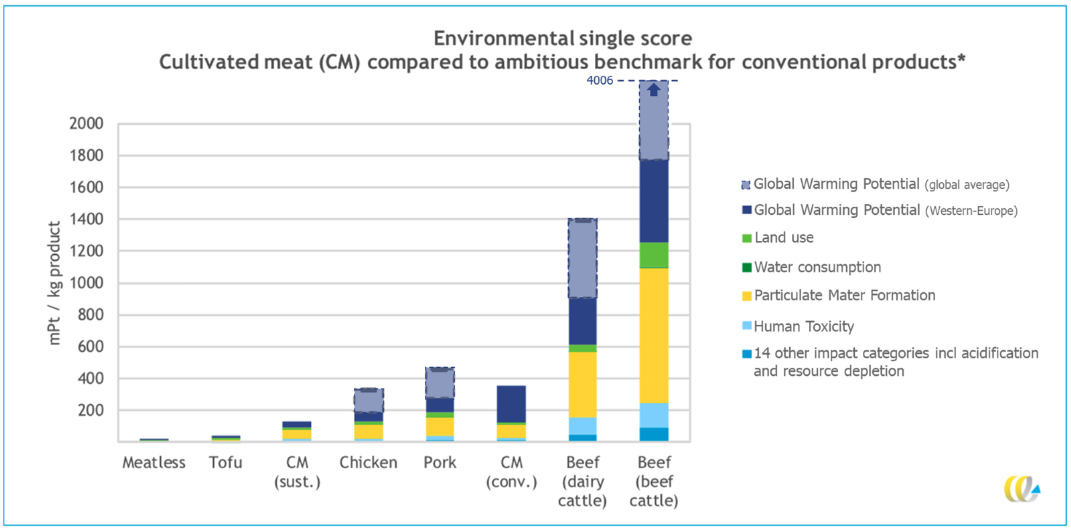Cultivated Meat: A Sustainable Alternative of Animal-based Protein or an Innovation That Creates More Environmental Challenges?
By Hyldeguard Lee and Meike Sauerwein

Cultivated meat, also known as lab-grown or cell-based meat, is gaining attention as a potential environmentally sustainable alternative to growing animals and slaughtering them to provide protein for human diets. On a cellular level it is identical to conventional meat as it is grown from actual animal-cells. It differs from plant-based meat (like ImpossibleTM, OmniFoods) which use protein extracted from peas, soybeans or other protein-rich plants. By growing animal cells in a controlled environment, cultivated meat offers a more humane alternative to animal agriculture, yet the input and infrastructure requirements create their own set of impacts. As this technology progresses, it is essential to assess its environmental impacts and acknowledge the challenges involved.
Traditional livestock farming is a major contributor to a variety of environmental problems. Cattle emit, due to enteric fermentation during their digestion process, large amount of the greenhouse gas methane. Furthermore, cows, pigs and chickens require large amounts of water and animal feed, which require additional amounts of agricultural land. Deforestation in developing countries is largely due to the immense needs for growing enough food to feed these animals. Animal faeces from large industrial agricultural significantly contribute to water pollution with antibiotics and excess nutrients. Heavily meat-based diet, like the average diet in Hong Kong, have been criticised for their high environmental impacts, especially in light of the need to reduce human impacts on the climate.
Cultivated meat holds the potential to significantly reduce the environmental footprint of meat production while having similar taste, texture and potentially more nutrients and no antibiotics residues. Yet, the major challenges of cultured meat production lie in the intensive energy requirement to run and clean a sophisticated setup of bioreactors, and the provision of a “culture medium” which contains buffered solutions made up of glucose, inorganic salt, water-soluble vitamins, and amino acids, as well as specific factors like growth factors, hormones, recombinant proteins, and lipids to support the growth of each specific cell type.
Culture medium production requires intensive input of nutrients, growth factors and energy to support and sustain the growth and proliferation of animal cells. The refinement of culture medium also has high energy demand, processes like purification and filtration often require energy-intensive equipment and generate chemical wastes which contribute further to its environmental impact. Therefore, strategies like combining low-impact ingredients and high-performance formulations to optimize the ingredients and formulation of culture medium production pose as the main objectives to minimize the environmental impact of cultivated meat production.
A recent study of beef-like, chicken-like and fish-like cultivated meat shows that it can outperform conventional meat almost all environmental impacts with lower land-use, human toxicity and particulate matter formation impacts. It also significantly reduces the carbon footprint compared to beef. Yet, cultured meat produces greenhouse gas (GHG) emissions of a similar magnitude when comparing to chicken and pork. In order to attain a lower impact on the climate than pork and chicken, at least 30% of energy consumption will have to be procured from low-carbon energy sources. While this poses a challenge, it also carries opportunities. As countries around the world are putting strong efforts into decarbonizing their electricity grid, the GHG impacts of cultivated meat will decrease. Less so for conventional agriculture: a reduction of the release of methane from cows and GHG from agricultural soils are far more difficult to achieve (if not impossible).

Figure 1. Environmental impacts traditional meat vs cultured meat (CM) in different environmental impact categories (using LCA method Eco-indicator 99, shown in the unit of millipoint (mPt) - reflecting a score that incorporates ecosystems, human health and resource use parameters). Based on datasets of west-European circular agriculture (with land use change-free soy); Source: CE Delft (2021)
For societies like Hong Kong where many citizens are self-proclaimed “meat-lovers", cultivated meat can be a great way to lower the carbon footprint of our diets, especially as a replacement of beef. Yet, it is important to acknowledge that challenges lie ahead as we move meat production from the farm to the processing plant. As the technology matures and we move towards decarbonizing the energy supply we also need to start thinking about how we can motivate consumers to try out this new alternative, address potential consumer concerns and let them know that cultured meat can not only bring benefits to the environment but also to consumers’ health.
The opinions expressed within the writeup are solely the author's and do not reflect the opinions of the HKUST Life Cycle Lab.
References: